You’ll find that ancient beading methods elevate modern designs through their time-tested techniques like peyote and brick stitch, which create stunning textured surfaces and intricate geometric patterns. These traditional approaches, perfected over millennia, bring cultural depth and symbolic meaning to contemporary jewelry while showcasing remarkable craftsmanship that can’t be replicated by machine production. The fusion of ancestral wisdom with modern materials creates pieces that carry both aesthetic beauty and spiritual significance, transforming simple beadwork into meaningful art that tells stories spanning generations.
The Timeless Foundation of Ancient Beading Craftsmanship
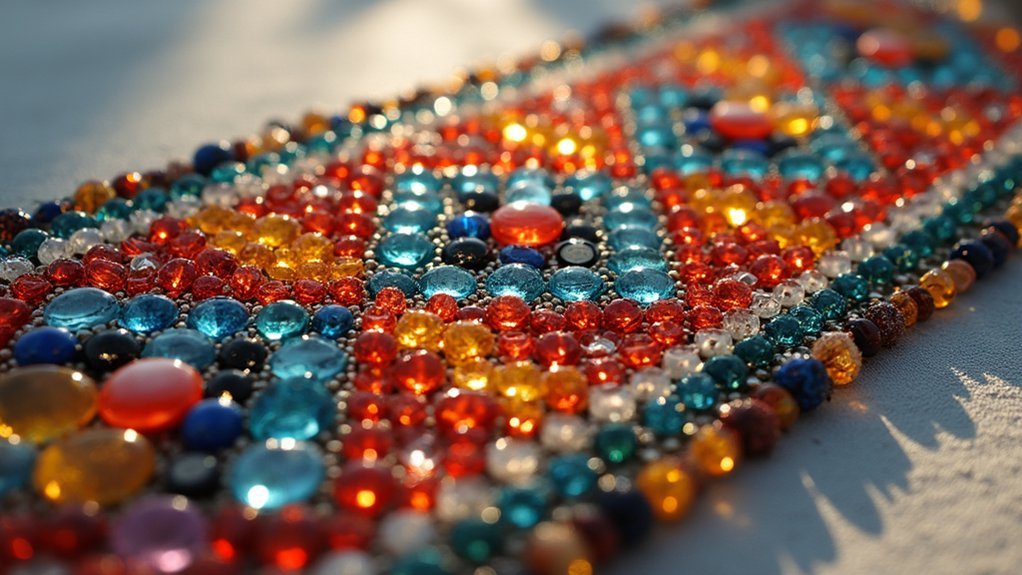
Artisans thousands of years ago laid the groundwork for beadwork techniques that remain relevant today.
When you examine ancient craftsmanship, you’ll discover hand-carving and primitive drilling methods that established essential skills still used in modern studios. These early artisans didn’t have advanced tools, yet they created intricate designs using natural materials like shells, bones, and stones.
You can trace your contemporary techniques directly to these ancient foundations.
Loom weaving and complex stitching patterns developed thousands of years ago remain vital for creating sophisticated beadwork today. The introduction of glass beads during ancient civilizations expanded color possibilities that you continue to leverage.
Each traditional bead carries cultural heritage that enriches your modern designs with historical narrative and artistic expression.
Cultural Heritage Woven Into Contemporary Jewelry Design
When you incorporate ancient beading techniques like peyote and brick stitch into your contemporary jewelry, you’re not just creating accessories—you’re preserving cultural narratives that span millennia.
These traditional techniques allow you to craft intricate beadwork with patterns that reflect deep cultural heritage and storytelling traditions.
You’ll find that using natural materials like shells and stones connects your designs to sustainability principles while honoring authentic indigenous practices.
When you weave these historical motifs into modern pieces, you’re creating jewelry that celebrates identity and educates wearers about rich cultural traditions.
Your contemporary jewelry becomes more than decoration—it’s a bridge between ancient wisdom and modern aesthetics, showcasing how traditional craftsmanship elevates today’s designs through meaningful cultural expression.
Traditional Stitching Techniques That Transform Modern Pieces
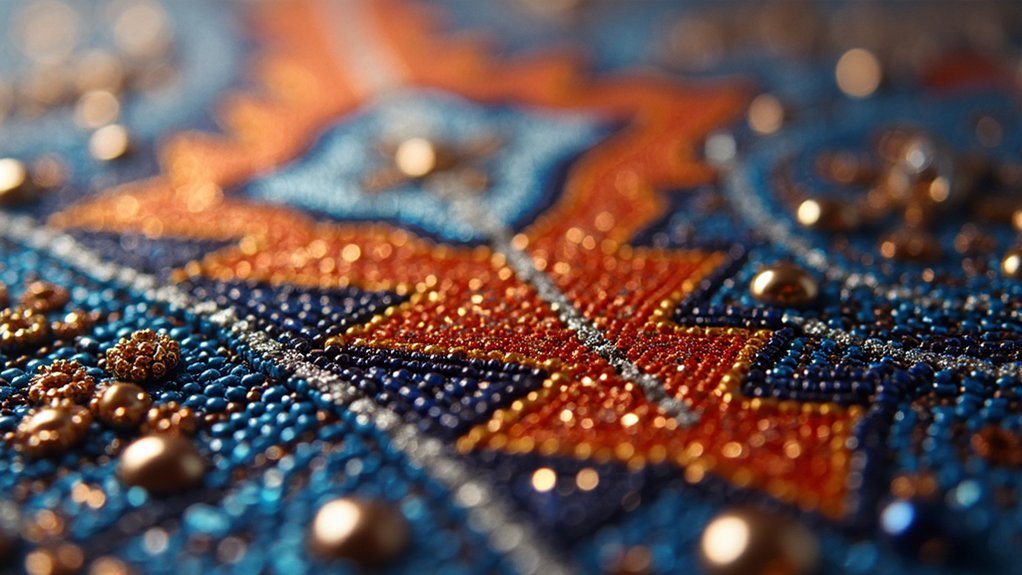
You’ll discover that traditional peyote stitch techniques create intricate patterns and textures that elevate contemporary jewelry designs beyond simple ornamentation.
When you master right-angle weave methods, you can craft complex geometric patterns that bridge ancient craftsmanship with modern aesthetic sensibilities.
These time-tested stitching approaches let you transform basic beadwork into sophisticated pieces that honor cultural heritage while meeting today’s design standards.
Peyote Stitch Revival
Centuries of Native American tradition converge with contemporary design as the peyote stitch experiences a remarkable revival in modern jewelry making.
You’ll find this traditional beading technique creates textured, intricate surfaces that modern jewelry designers can’t resist. The stitch’s versatility lets you craft both flat pieces and three-dimensional works, opening doors to innovative shapes and forms that weren’t possible before.
What makes this revival meaningful is how it honors indigenous cultures while embracing evolution.
You’re not just learning a technique—you’re connecting with stories and cultural significance passed down through generations. When you incorporate contemporary materials and current color palettes, you’re bridging ancestral wisdom with today’s fashion trends, creating pieces that carry both aesthetic appeal and deeper meaning.
Right-Angle Weave Innovation
As geometric precision meets creative freedom, the right-angle weave transforms modern jewelry through its distinctive square-based structure.
You’ll discover that this technique creates intricate beadwork with exceptional dimensional depth, making your pieces visually striking and tactilely engaging. The square formation doesn’t just enhance aesthetics—it considerably increases durability, ensuring your creations withstand daily wear.
When you embrace right-angle weave, you’re blending traditional craftsmanship with contemporary vision, preserving cultural heritage while attracting modern audiences.
This versatile technique adapts seamlessly from delicate bracelets to statement necklaces and larger decorative works. You can experiment boldly with color combinations and materials within this ancient framework, producing innovative designs that honor time-tested methods while pushing creative boundaries.
Your durable pieces become bridges between past and present artistry.
How Loom Weaving Methods Enhance Today’s Beadwork
When ancient loom weaving techniques meet modern beadwork, they create extraordinary possibilities that transform ordinary designs into stunning artistic statements.
You’ll discover that loom weaving enables complex designs with precise geometric patterns that traditional methods couldn’t achieve consistently.
The structured approach guarantees your intricate patterns maintain perfect spacing and alignment, delivering professional-quality results every time.
The Art of Peyote Stitch in Modern Jewelry Applications
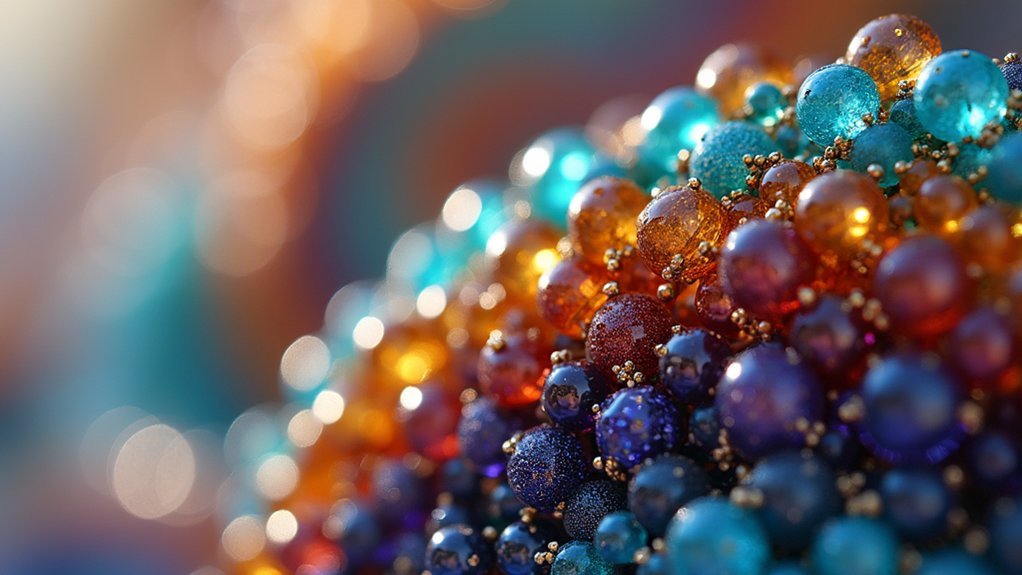
You’ll find that peyote stitch creates stunning textured surfaces through its signature staggered bead pattern, making it perfect for both flat pendants and tubular bracelets in today’s jewelry market.
This versatile technique lets you craft intricate geometric designs while incorporating vibrant colors and mixed materials that bridge traditional craftsmanship with contemporary fashion trends.
When you combine peyote stitch with other methods like right-angle weave, you’re able to develop innovative pieces that showcase both historical techniques and modern aesthetic preferences.
Peyote Stitch Basics
Three fundamental variations of peyote stitch form the backbone of modern jewelry design, each offering distinct advantages for contemporary artisans.
You’ll discover that even-count peyote stitch creates symmetrical patterns perfect for bracelets and geometric designs, while odd-count variations allow for more complex artistic expression through asymmetrical shapes.
When you master this traditional beadwork technique, you’re connecting with Native American cultures while crafting contemporary pieces.
The alternating row structure lets you create both flat and tubular surfaces, enabling intricate patterns that blend cultural heritage with modern aesthetics.
You can incorporate vibrant color combinations that weren’t possible with ancient materials, yet you’re preserving the essential craftsmanship techniques.
This versatile foundation transforms simple beads into sophisticated modern jewelry that honors ancestral wisdom.
Contemporary Jewelry Applications
Modern jewelry designers have embraced peyote stitch as a cornerstone technique for creating statement pieces that capture today’s fashion sensibilities. This traditional technique offers you incredible versatility, allowing you to craft both flat surfaces and dimensional pieces that showcase intricate patterns.
When you combine vibrant colors with innovative materials, you’ll transform ancient methods into striking modern interpretations.
Contemporary jewelry applications include:
- Statement cuffs – Create bold, textured bracelets that make powerful fashion statements
- Layered necklaces – Design multi-dimensional pieces that complement current stacking trends
- Geometric earrings – Craft structured designs that blend traditional techniques with modern aesthetics
You’ll find peyote stitch accessible whether you’re a beginner or experienced artisan, making it perfect for personal expression in today’s competitive jewelry market.
Modern Design Integration
While maintaining deep respect for its ancestral roots, contemporary artisans have revolutionized peyote stitch by seamlessly blending traditional techniques with cutting-edge design principles.
You’ll discover how modern jewelry designers transform ancient traditional patterns into sophisticated pieces that speak to today’s aesthetic sensibilities. By incorporating eco-friendly materials like recycled glass beads, you’re supporting sustainability while creating stunning handcrafted pieces.
The peyote stitch’s adaptability enables you to craft intricate designs that combine multiple techniques, such as right-angle weave, resulting in complex textures and dimensional elements.
You can create contemporary bracelets and necklaces that showcase vibrant color combinations while honoring cultural heritage. This integration allows you to produce modern jewelry that connects wearers with traditional artistry through uniquely crafted, environmentally conscious accessories.
Indigenous Pattern Stories That Inspire Current Designers
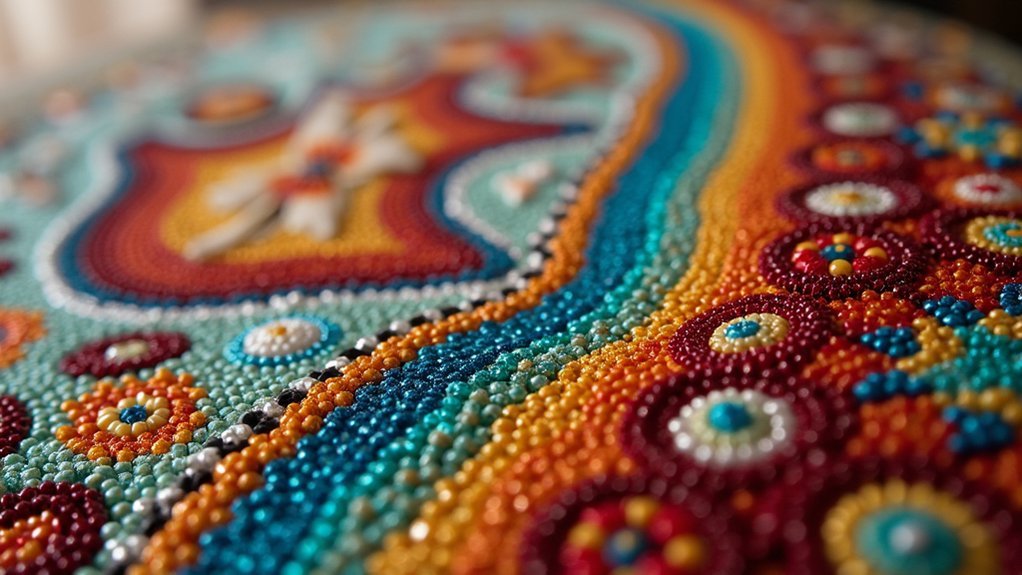
Indigenous beading traditions carry profound narratives within their intricate patterns, transforming each piece into a visual storytelling medium that today’s designers enthusiastically study and respectfully adapt.
When you examine traditional craftsmanship, you’ll discover that indigenous beadwork serves as cultural documentation, preserving ancestral wisdom through geometric motifs and symbolic representations.
Modern designers draw inspiration from these meaningful patterns in three key ways:
- Cultural identity exploration – Incorporating traditional symbols that represent heritage and spiritual beliefs into contemporary designs
- Natural element interpretation – Using vibrant colors and animal motifs that reflect environmental connections
- Collaborative storytelling – Partnering with indigenous artisans to honor authentic narratives while creating innovative fashion statements
This approach to storytelling through beadwork promotes sustainability by valuing traditional knowledge systems and fostering respectful cultural exchange in contemporary designs.
Material Wisdom From Ancient Artisans to Modern Creators
You’ll discover that ancient artisans’ choice between natural materials like bones, shells, and stones versus today’s synthetic alternatives reveals fundamental differences in sustainability and aesthetic appeal.
Their traditional crafting techniques—from primitive tool work to advanced loom weaving—continue to shape how you approach modern beadwork construction.
Understanding the cultural symbolism embedded in these ancient material choices helps you create designs that honor historical significance while expressing contemporary artistic vision.
Natural Materials Vs Synthetics
As ancient artisans selected materials from their immediate surroundings, they developed an intimate understanding of how bone, shell, wood, and stone could transform into meaningful adornments that connected them directly to their environment.
Today’s creators face a choice between honoring these traditional practices with natural materials or embracing synthetic alternatives.
When you’re choosing between natural materials and synthetic options for bead-making, consider:
- Cultural significance – Natural materials carry spiritual meaning that’s been valued for thousands of years.
- Environmental impact – Eco-friendly and sustainable materials align with ancient wisdom while supporting modern conservation efforts.
- Artistic expression – Synthetics offer durability and color variety, while naturals provide authentic texture and story.
You’ll find that many contemporary artisans blend both approaches, creating designs that honor tradition while embracing innovation.
Traditional Crafting Techniques
Through generations of patient practice and experimentation, ancient artisans mastered techniques that modern creators still rely on today—from the precise tension control required for loom weaving to the rhythmic patterns of peyote and brick stitching.
These traditional crafting techniques showcase remarkable ingenuity, as ancient artisans created intricate designs using sustainable materials like shells, bones, and stones with limited resources.
You’ll find that mastering these foundational methods elevates your contemporary beadwork considerably.
When you integrate techniques like peyote and brick stitch into modern pieces, you’re not just creating jewelry—you’re preserving cultural significance while developing contemporary aesthetics.
Ancient Egypt’s glass bead innovations expanded color possibilities that you can still explore today, proving these time-tested methods remain relevant for creating detailed, textured pieces.
Cultural Symbolism in Design
When ancient artisans selected deep indigo blues or vibrant ochre reds for their beadwork, they weren’t simply choosing attractive colors—they were embedding profound cultural messages that transcended mere decoration.
You’ll discover that color symbolism in traditional patterns carries profound meaning, with each hue representing emotions, social status, or spiritual beliefs that continue influencing modern designs today.
Understanding these cultural narratives enhances your appreciation of contemporary beadwork:
- Sacred geometries from Native American traditions convey creation stories and tribal identity.
- African motifs represent community values, ancestral wisdom, and protective symbolism.
- Natural material choices reflect environmental connections and spiritual relationships.
When you incorporate ancient techniques into your modern creations, you’re not just crafting jewelry—you’re participating in millennia-old storytelling traditions that celebrate heritage while creating meaningful contemporary art.
Sacred Geometry and Symbolic Motifs in Contemporary Beading
Contemporary bead artists revitalize ancient wisdom by weaving sacred geometry and symbolic motifs into their designs, creating jewelry that transcends mere decoration. You’ll discover that circles, triangles, and spirals carry spiritual significance across cultures, representing cosmic order and universal connection. When you incorporate these ancient designs into contemporary beading, you’re honoring ancestral traditions while creating pieces with modern aesthetics that resonate across generations.
| Sacred Shape | Cultural Meaning | Modern Application |
|---|---|---|
| Circle | Unity, wholeness | Mandala-inspired pendants |
| Triangle | Balance, harmony | Geometric earrings |
| Spiral | Growth, evolution | Wire-wrapped bracelets |
| Animal motifs | Ancestral wisdom | Totem jewelry pieces |
These symbolic motifs help you convey cultural narratives while enhancing visual appeal, creating meaningful connections between identity, spirituality, and community through your artistry.
Hand-Passed Techniques That Elevate Artisanal Quality
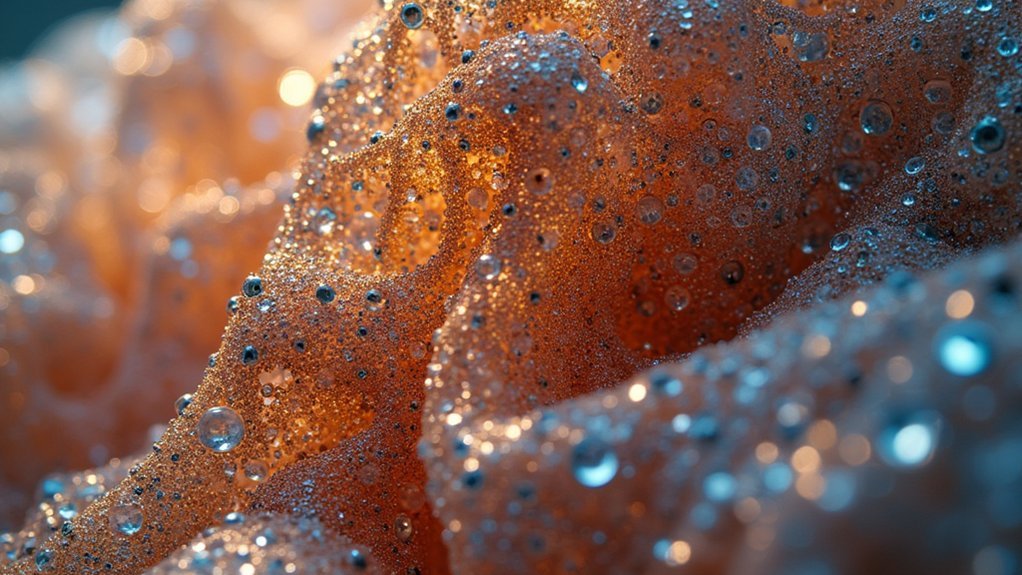
Beyond incorporating meaningful symbols into your beadwork, mastering traditional hand-passed techniques transforms your pieces from simple jewelry into heirloom-quality art.
These handcrafted methods demand patience and precision, but they’ll elevate your work beyond mass-produced alternatives.
Handcrafted beadwork requires dedication and skill, but creates distinctive pieces that surpass factory-made jewelry in quality and character.
When you embrace these time-honored techniques, you’re gaining:
- Unique texture and durability – Peyote and brick stitches create intricate patterns that machines can’t replicate
- Cultural authenticity – You’re connecting with generations of artisans who perfected these methods
- Sustainable craftsmanship – Natural materials like bones and shells enhance your designs’ environmental appeal
Each stitch you make by hand guarantees superior quality and individuality.
Traditional techniques require meticulous attention, but they promise your beadwork stands apart in today’s market, appealing to consumers who value authentic, sustainable artistry.
Bridging Cultures Through Traditional and Modern Beading Fusion
As global markets increasingly value authenticity and cultural connection, you can create stunning pieces that honor ancient traditions while meeting modern aesthetic demands.
When you integrate indigenous techniques like peyote and brick stitch into contemporary beadwork, you’re bridging centuries-old wisdom with today’s fashion sensibilities.
This cross-cultural fusion allows you to draw from diverse patterns and motifs, creating unique designs that celebrate multiple cultural heritage traditions simultaneously.
Preserving Ancient Methods While Innovating for Today’s Market
While ancient beading techniques remain timeless in their beauty, you’ll find that successful preservation requires strategic innovation to capture today’s market.
You can honor cultural heritage while embracing change through thoughtful adaptation of traditional techniques.
Here’s how you can balance preservation with market demands:
- Blend traditional techniques with innovative materials – Combine peyote stitching with modern synthetic beads to create vibrant, durable pieces.
- Integrate storytelling into contemporary beadwork – Share the cultural significance behind each technique through product descriptions and workshops.
- Implement ethical practices – Source materials responsibly and partner with artisan communities to support sustainable livelihoods.
You’ll discover that this approach doesn’t dilute tradition but strengthens it, creating meaningful connections between ancient wisdom and modern consumers while ensuring these precious crafts thrive.
Frequently Asked Questions
What Is the Significance of Beading?
You’ll find beading’s significance spans communication, storytelling, and cultural identity across 100,000 years. Each bead carries deep meaning, representing your heritage, spiritual beliefs, and social status within communities worldwide.
What Is the Historical Significance of Beads?
You’ll find beads carry profound historical weight, serving as humanity’s earliest decorative art for 100,000 years. They’ve communicated social status, spiritual beliefs, and cultural identity across civilizations, from ancient Egyptian burial rituals to tribal traditions.
Why Is Beading Important to Native American Culture?
You’ll find beading preserves your cultural identity through storytelling patterns and spiritual symbols. It connects you to ancestral traditions, strengthens community bonds, provides economic opportunities, and maintains sacred practices passed down through generations.
What Are the Benefits of Beading?
You’ll discover beading enhances your creativity while providing therapeutic stress relief. It connects you to cultural heritage, promotes mindfulness through repetitive motions, and lets you create meaningful artifacts using sustainable, eco-friendly materials.
In Summary
You’ll discover that incorporating ancient beading methods into your modern designs doesn’t just add visual appeal—it connects you to centuries of cultural wisdom and craftsmanship. These time-tested techniques bring authenticity and depth that mass-produced jewelry can’t match. By mastering traditional stitches like peyote weave and loom work, you’re not only preserving invaluable heritage but creating pieces with soul, meaning, and unmatched artisanal quality that today’s discerning customers truly value.

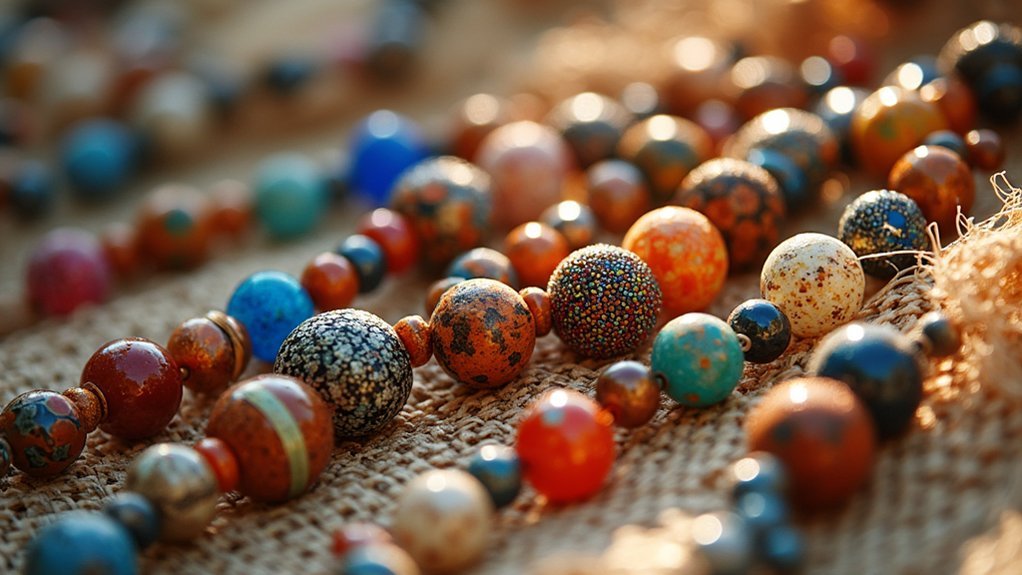



Leave a Reply